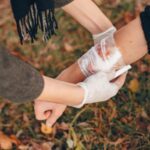A facelift is a surgical procedure to tighten and firm the skin on your face and neck so you appear younger. Many wrinkles may be removed, but your skin’s texture is unaffected. Swelling under chin after facelift is a common side effect.
Swelling Under Chin After Facelift
After any facelift procedure, swelling is typical and expected. In nearly all instances, it gradually goes away without treatment. The lymphatic drainage system transports the body’s natural fluid through the body and back to the heart. It needs time to repair in addition to the typical healing (i.e., acute inflammatory) response following surgery.
Consult your surgeon if the fluid is dripping from a closed wound. The body will eventually reabsorb small amounts of fluid. A drain and compression might be necessary if there is more of it. For the skin to adequately tighten and create a smooth facelift shape, it is critical to drain the fluid to prevent infection.
How to reduce swelling under chin after facelift?
Luckily, patients can use a variety of techniques to hasten the healing of swelling following surgery. Please be aware that not every patient may benefit from the strategies listed below. All of the below-mentioned treatments have advantages, disadvantages, and alternatives, such as time itself.
If you are worried about your face or neck, look for a facial plastic surgeon who has completed a fellowship. Ask your surgeon about their preferred methods for minimizing swelling following a facelift.
Lymphatic Massage
After surgery, lymphatic massage can often begin four to six weeks later. While the lymphatic system is healing, lymphatic massage can help to drain fluid from the face. But, it needs to be done by someone skilled and knowledgeable about the suitable method.
Elevation of Head
Two weeks after surgery, patients are strongly advised to raise their heads while sleeping by resting on a recliner or two pillows. Due to the increased effects of gravity, the lymphatic fluid in the body can now travel away from the face more effectively. Read more about the benefits of sleeping on your back.
Steroid Injections
Sometimes, several weeks after surgery, low-dose, low-concentration steroids can be injected into the deep tissue to hasten the healing of small areas of significant, long-lasting swelling. The average time for these injections to start working is two weeks.
Patients are warned that among the potential dangers of steroid injections, there is a low chance of soft tissue atrophy, changes in skin color, and the growth of small blood vessels, called telangiectasias, on the skin following steroid injection.
Oral Steroids
To hasten the clearance of tiny areas of severe, persistent swelling, low-dose, low-concentration steroids may be administered into the deep tissue beginning many weeks after surgery. These injections often take two weeks on average to start working.
According to patient counseling, the growth of small blood vessels on the skin, known as telangiectasias, changes in skin color, and atrophy of soft tissue are low-risk side effects of steroid injections.
Observe our post-surgical guidelines.
The purpose of post-operative instructions is to ensure that patients recover fully from surgery. Going against these recommendations could result in serious setbacks, swelling, and discomfort. Feel free to ask any questions if you have any concerns.
These guidelines could state:
- Incision
- If you have tape strips covering the incision (cut) the doctor made, keep them there for a week or until they come off naturally. Or you can remove the tape by following your doctor’s recommendations.
- Wash the incisions with warm water and carefully dry the area once your doctor gives the all-clear. Alcohol and hydrogen peroxide can impede healing; avoid using them.
- Unless your doctor instructs you to do so, avoid applying lotions or ointments to your incisions.
- Activity
- Find out from your doctor when you can resume driving.
- Observe the showering instructions provided by your doctor. You might be able to shower a day or two following surgery.
- If you have problems opening your mouth, use a baby toothbrush to brush your teeth.
- For a few months, switching to an electric razor may be helpful to get the feeling back in your face and neck’s skin. Because you won’t be able to feel the blade on your skin when shaving after a facelift, proceed with extreme caution.
Continue reading about tips for quick recovery.
Apply ice compresses
Cool compresses are frequently used to treat soft tissue wounds. Additionally, people who get facelift surgery can benefit from this practice. You feel more at ease due to the chilly sensation’s ability to constrict your blood vessels. Don’t apply ice straight to the healing skin; periodically remove your skin from the cold.
Keep heat sources at bay
Heat can accentuate swelling, while cold can reduce it. Because of this, our facial plastic surgeon advises avoiding heat sources while your facelift is healing. Avoid going outside, using heat lamps, and taking hot showers when recovering. Avoid overheating yourself by remaining indoors near your air conditioner.
Rest Enough
Setting up a relaxing area in your house for recovery is crucial. Ensure your bedroom has everything you’ll need for the recuperation process, including extra pillows, relaxing music, easy access, water, snacks, and anything else you might require. Try to get 8 hours of sleep every night, and if you need to, take naps during the day. Ample rest will limit swelling and aid in the recuperation process.
Stay Hydrated
Drinking water is essential for your overall health and your recovery. Water helps your body eliminate the excess fluid trapped inside your tissues. The more water you drink, the less fluid retention you’ll have. Aim to drink at least 6 to 8 glasses of water a day. Avoid drinking caffeinated beverages that can dehydrate your body and consume water-rich fruits and vegetables instead.
Water is free and readily available and will undoubtedly be your best friend during recovery.
Eat Right
When you are confined to bed, it is incredibly tempting to order your favorite dishes online. It is not a good idea, though, after surgery. Eat some freshly prepared, low-sodium meals. Steer clear of processed foods, fast food, and any other foods with a high salt level. You will undoubtedly notice a reduction in the swelling and an increase in your energy levels if you consume enough of fruit, vegetables, healthy carbs and fats, and protein.
When to seek immediate medical attention?
Immediately seek medical attention if
- You are experiencing pain that does not go away even after taking medication.
- Your incision becomes visible, or your stitches are loose.
- From the cut, you’re bleeding.
- You exhibit infection-related symptoms such as
- heightened pain
- Swelling
- Warmth
- redness.
- Red lines extend from the cut.
- Pus is draining from the wound.
- You suffer from flu
- You have pain in your calf, back of the knee, thigh, or groin, indicating a blood clot in your leg.
- Swelling and redness in the leg or groin swelling and redness.
Keep an eye out for any changes in your health, and call your doctor or nurse advice line if you are not improving as predicted.
Conclusion
Swelling under chin after facelift is typical and to be expected. Everyone heals differently. However, some people hold onto a bit more fluid for a while. Most patients can typically resume their normal activities two weeks after the operation, and most can look decent with cosmetics in 14 days.
To know more about the recovery time after a facelift, consider reading. If it persists, consult your doctor immediately, as it might be a sign of infection.
An essential component of your treatment and security is follow-up care. Make careful you schedule and keep all appointments, and if you experience any difficulties, call your doctor or nurse advice line. One of the best decisions also involves knowing your test findings and keeping track of the medicines you take.









